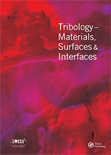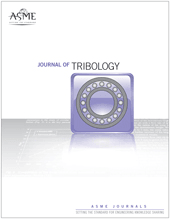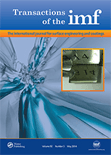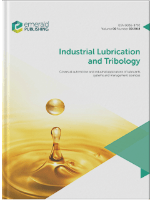
Tribology-Materials Surfaces & Interfaces
Scope & Guideline
Innovating solutions through the science of interactions.
Introduction
Aims and Scopes
- Tribological Performance Evaluation:
The journal emphasizes the assessment of tribological performance across various materials, including metals, polymers, and composites. This involves experimental studies to measure friction, wear, and lubrication efficiency under different conditions. - Surface Engineering and Coatings:
A significant focus is on surface modification techniques, such as coatings (PVD, HVOF, etc.), that enhance the wear resistance and tribological properties of materials. This includes the development and characterization of novel coatings and surface treatments. - Material Development and Characterization:
Research on new materials, particularly composites and high-entropy alloys, is a core area. This includes studying the mechanical and tribological behavior of these materials to innovate and improve performance in various applications. - Artificial Intelligence and Machine Learning Applications:
An emerging methodological focus is the application of AI and machine learning techniques in predicting and optimizing tribological performance, such as predicting wear patterns and improving machining processes. - Sustainable Lubrication:
The journal also addresses the growing need for sustainable practices in tribology, including the exploration of bio-based lubricants and environmentally friendly materials to reduce ecological impacts.
Trending and Emerging
- Nanocomposite and Hybrid Materials:
There is an increasing focus on the development and study of nanocomposite and hybrid materials, which leverage nanoparticles to enhance tribological properties. This trend is crucial for applications requiring high performance in compact and lightweight forms. - Tribocorrosion Studies:
Research on tribocorrosion, which combines tribology and corrosion, is gaining prominence. This is particularly relevant for biomedical applications and environments where materials are exposed to both mechanical wear and corrosive conditions. - AI and Predictive Modeling in Tribology:
The use of artificial intelligence and predictive modeling to optimize tribological performance is emerging as a significant trend. This includes leveraging machine learning for wear prediction and process optimization, indicating a shift toward data-driven methodologies. - Sustainable and Bio-based Lubricants:
The journal is increasingly publishing studies on sustainable and bio-based lubricants, reflecting global trends toward sustainability. Research in this area focuses on reducing environmental impact while maintaining performance. - Advanced Surface Coatings:
Emerging studies on advanced surface coatings, such as those using nanoparticles or new deposition techniques, are on the rise. These innovations are aimed at enhancing the durability and performance of coatings in demanding applications.
Declining or Waning
- Traditional Lubricants:
There is a noticeable decrease in research focused on traditional mineral-based lubricants, as newer, more sustainable alternatives are gaining attention. This shift indicates a growing trend towards environmentally friendly solutions. - Single Material Studies:
Research solely focused on traditional single-material tribological studies is declining. Increasingly, studies are exploring multi-material systems or composites that provide enhanced performance, indicating a trend towards complexity in material interactions. - Basic Friction Phenomena:
Papers concentrating on fundamental friction phenomena without application to specific engineering problems or advanced materials are becoming less common. The journal is moving towards more applied and interdisciplinary approaches.
Similar Journals

JOURNAL OF TRIBOLOGY-TRANSACTIONS OF THE ASME
Unveiling the Science of Surfaces and InteractionsJOURNAL OF TRIBOLOGY-TRANSACTIONS OF THE ASME, published by the esteemed American Society of Mechanical Engineers (ASME), is a prominent peer-reviewed journal dedicated to the intricate study of tribological phenomena and their impact on mechanical systems. With an ISSN of 0742-4787 and an E-ISSN of 1528-8897, this journal has been a vital resource since its inception in 1967, covering significant developments in mechanical engineering, mechanics of materials, surfaces, and interfaces. Ranked in the Q2 quartile across multiple categories for 2023, including Mechanical Engineering and Surfaces and Interfaces, it reflects a respectable impact within the research community, with Scopus rankings highlighting its stature in various related fields. While it does not offer open access, its contributions to the understanding of wear, lubrication, and surface engineering are invaluable for researchers, professionals, and students alike, fostering advancements in both academic and industrial applications. With a commitment to disseminating high-quality research, this journal continues to be an essential platform for those seeking to push the boundaries of tribology and its applications.

TRANSACTIONS OF THE INSTITUTE OF METAL FINISHING
Advancing Knowledge in Surface Engineering and Materials ScienceTRANSACTIONS OF THE INSTITUTE OF METAL FINISHING, published by Taylor & Francis Ltd, is a premier journal dedicated to the field of metal finishing and surface engineering. With an ISSN of 0020-2967 and E-ISSN of 1745-9192, this journal has been a critical resource for researchers and practitioners since its inception in 1969. Covering a broad scope that includes condensed matter physics, mechanics of materials, and the intricate science of metals and alloys, TRANSACTIONS OF THE INSTITUTE OF METAL FINISHING has established itself within the academic community, currently holding Q2 and Q3 rankings across multiple relevant categories in 2023. While not openly accessible, the journal remains a vital compendium of innovative research findings and advancements, attracting contributors and readers eager to explore cutting-edge developments in metal finishing techniques and applications. The insightful articles published here cater to a wide audience, including industry professionals, academic researchers, and students, who seek to improve their understanding of materials science and engineering practices.

JOURNAL OF THERMAL SPRAY TECHNOLOGY
Catalyzing Progress in Thermal Spray MethodologiesJOURNAL OF THERMAL SPRAY TECHNOLOGY, published by SPRINGER, is a leading platform dedicated to the advancement of thermal spray processes and materials, providing high-quality research pertinent to both industrial applications and scientific inquiry. With an ISSN of 1059-9630 and E-ISSN 1544-1016, this journal holds a distinguished position within the academic community, as evidenced by its Q2 rankings across multiple categories including Condensed Matter Physics, Materials Chemistry, and Surfaces, Coatings and Films. The journal serves as an essential resource for researchers, professionals, and students, offering insights into innovative methodologies, emerging technologies, and critical reviews within the field of thermal spray technology. As it converges from 1992 to 2024, it continues to expand its impact, fostering collaboration and dialogue among experts, and contributing significantly to material science disciplines. With a consistent focus on cutting-edge research and practical applications, this journal remains vital for those invested in the future of materials technology.

Tribology International
Shaping the Future of Mechanical Engineering Through Tribology.Tribology International, published by ELSEVIER SCI LTD, stands as a premier journal in the fields of tribology, mechanical engineering, and material science. With an impressive impact factor and ranking in the Q1 category across multiple disciplines such as Mechanical Engineering and Surfaces, Coatings and Films, this journal serves as a critical resource for researchers, professionals, and students looking to advance their knowledge and application of tribological principles. Established in 1972, Tribology International explores a wide array of topics, including friction, wear, and lubrication, making it indispensable for those dedicated to innovation in engineering and materials sciences. With its rigorous peer-review process and high visibility within the academic community, Tribology International is pivotal in disseminating influential research, fostering new ideas, and shaping the future of tribological research.

TRIBOLOGY LETTERS
Pioneering Research at the Intersection of Surfaces and ScienceTRIBOLOGY LETTERS is a distinguished peer-reviewed academic journal published by SPRINGER/PLENUM PUBLISHERS, focusing on advancements in the field of tribology and its applications across various engineering domains. With an ISSN of 1023-8883 and an E-ISSN of 1573-2711, this journal serves as a crucial platform for disseminating cutting-edge research and technological innovations, operating from its esteemed headquarters in the United States. The journal is categorized in the Q2 quartile across multiple domains including Mechanical Engineering, Mechanics of Materials, Surfaces and Interfaces, and Surfaces, Coatings and Films, showcasing its significant impact within the respective fields. With Scopus rankings placing it in the top 25% for Engineering and top 20% for Physics and Astronomy related categories, TRIBOLOGY LETTERS continues to be an essential resource for researchers, professionals, and students looking to deepen their understanding of tribological phenomena and enhance their applications in industry and technology. While it does not currently offer open access options, the journal continues to invite high-quality contributions that contribute to the ongoing dialogue and advancement in tribological science.

Journal of Coatings Technology and Research
Pioneering Research in Coatings and Materials ScienceThe Journal of Coatings Technology and Research, published by Springer, stands as a vital resource for researchers and professionals in the fields of materials science and chemistry. With an ISSN of 1547-0091 and an E-ISSN of 1935-3804, this journal is recognized for its significant contributions to the study of coatings technology, encompassing diverse aspects from surfaces and interfaces to colloids and surface chemistry. Currently holding a 2023 Impact Factor that places it in the Q2 and Q3 quartiles across several categories—including Chemistry and Colloid and Surface Chemistry—the journal serves as an essential platform for disseminating innovative research. Its accessibility options cater to a broad audience, ensuring that both established scholars and emerging researchers can engage with the latest findings. Since its inception in 2004, the journal has continued to foster advancements in coatings technologies, promoting sustainable practices and novel applications across industries.

JOURNAL OF MATERIALS ENGINEERING AND PERFORMANCE
Pioneering Research in Materials EngineeringJOURNAL OF MATERIALS ENGINEERING AND PERFORMANCE, published by Springer, serves as a vital resource for researchers and professionals in the fields of materials science, mechanical engineering, and mechanics of materials. With an ISSN of 1059-9495 and E-ISSN of 1544-1024, this journal boasts a commendable track record since its inception in 1992 and is set to continue providing valuable insights until 2024. Positioned in the Q2 quartile of its categories, the journal is ranked #246 in Mechanical Engineering and #168 in Mechanics of Materials according to Scopus, reflecting its commitment to high-quality research. While currently not adopting an open access model, it remains accessible to academic professionals and students eager to advance their knowledge in the rapidly evolving domain of materials engineering. The scope encompasses innovative research focused on material performance, engineering applications, and technological advancements, making it an indispensable tool for those at the forefront of the field.

Tribology Online
Unlocking the potential of materials with cutting-edge research.Tribology Online, published by the Japan Society of Tribologists, is a dynamic open-access journal dedicated to the domain of tribology, encompassing research on surfaces, coatings, and films. Launched in 2013, this journal serves as a crucial platform for disseminating innovative findings in the field, highlighting its commitment to advancing knowledge and practice in tribological science. With an impact factor that places it in the Q3 quartile for the category of Surfaces, Coatings and Films, Tribology Online ranks 93rd out of 132 journals in its field, reflecting a growing engagement from the academic community. Open access since 2017, the journal promotes wide accessibility to research trends and technological advancements, making it an essential resource for researchers, professionals, and students pursuing cutting-edge developments in material sciences. Based in Tokyo, Japan, it aims to connect global experts and contribute to the evolution of tribological knowledge.

Lubricants
Empowering research in lubrication for diverse industries.Lubricants, published by MDPI, is a prestigious, peer-reviewed open-access journal that has been dedicated to advancing the field of lubrication technology since its launch in 2013. With its E-ISSN of 2075-4442, the journal is based in Switzerland and has rapidly established itself as a vital resource in the domains of Mechanical Engineering and Materials Science, achieving Q2 quartile rankings in both fields as of 2023. Lubricants provides a platform for the dissemination of innovative research, offering insights into the performance, formulation, and applications of lubricants across various industries. With a commitment to fostering collaboration and knowledge-sharing, this journal attracts a global audience of researchers, professionals, and students eager to explore the latest developments in lubrication technologies. Open access since its inception, Lubricants ensures that all published works are freely available, promoting greater visibility and accessibility of cutting-edge research in the field.

INDUSTRIAL LUBRICATION AND TRIBOLOGY
Exploring the intersection of efficiency and innovation in tribology.INDUSTRIAL LUBRICATION AND TRIBOLOGY, published by EMERALD GROUP PUBLISHING LTD, is a distinguished journal dedicated to the fields of lubrication science and tribology, examining the fundamental aspects and innovative applications that enhance energy efficiency and mechanical performance in industrial settings since its inception in 1948. With an ISSN of 0036-8792, the journal is indexed in recognized databases, and its significant contributions have earned it a respectable Q3 category ranking in the disciplines of Energy, Mechanical Engineering, and Surfaces, Coatings, and Films. Researchers and professionals engaged in these fields will find valuable insights and cutting-edge research that drive innovation and improve the sustainability of industrial practices. While the journal does not currently offer open access options, it continues to be a pivotal platform for disseminating knowledge among scholars and practitioners. Its ongoing relevance in advancing tribological science highlights the critical role of lubrication in enhancing machine longevity and operational efficiency.